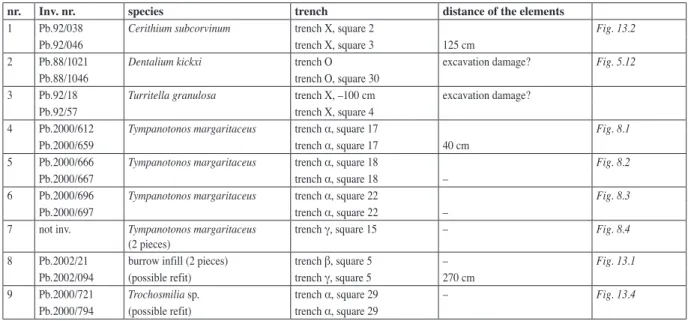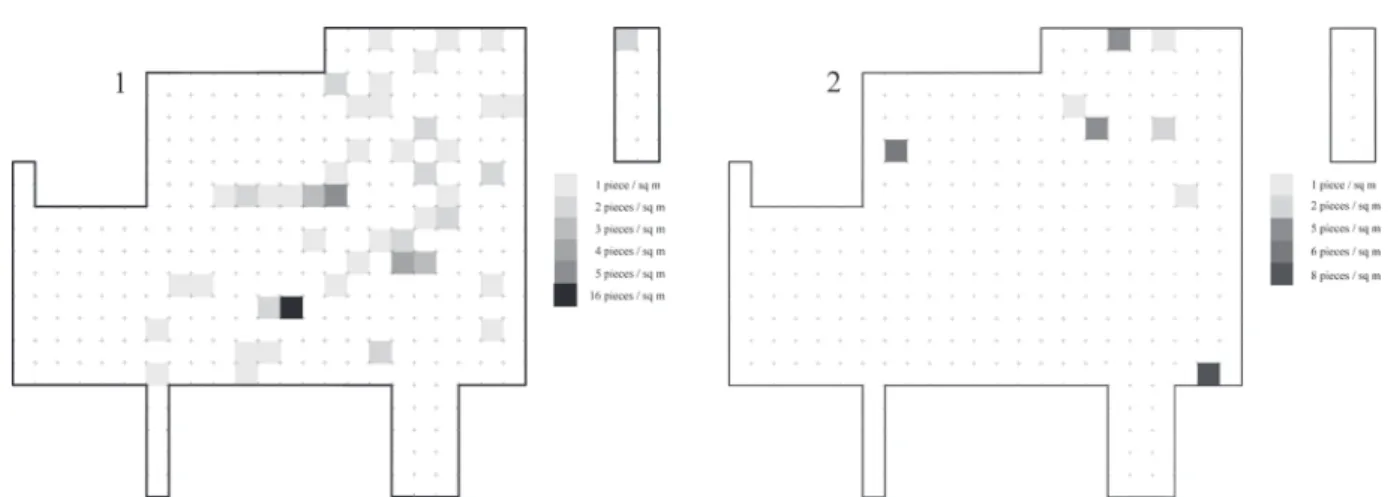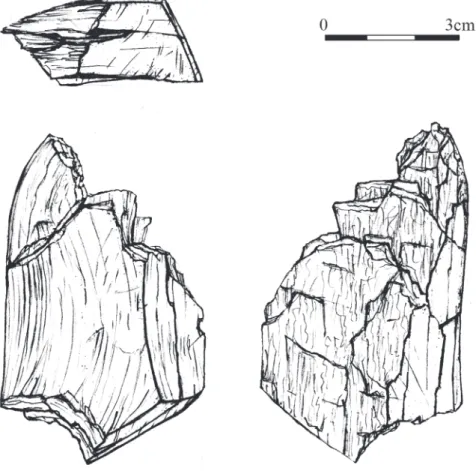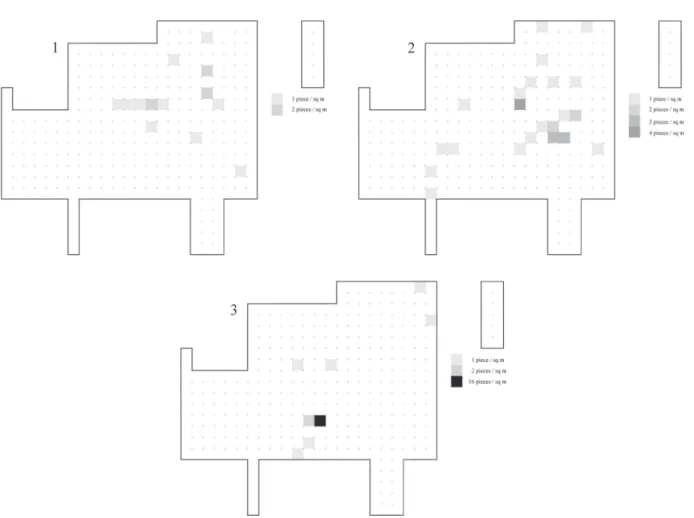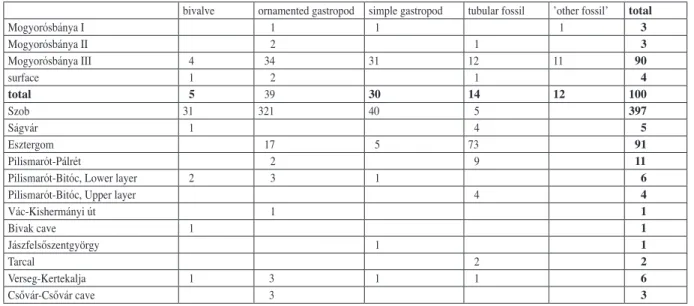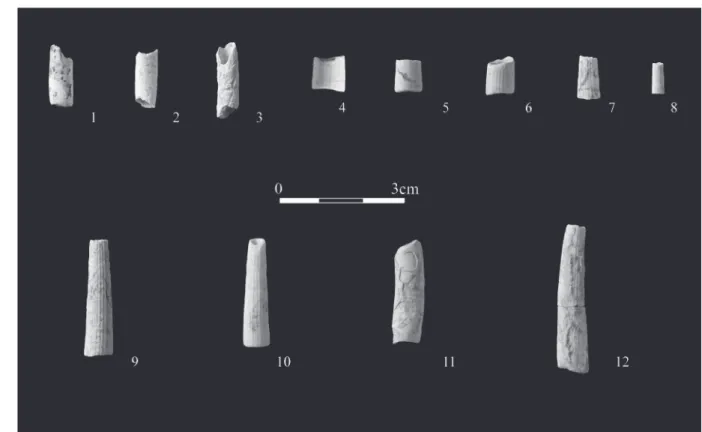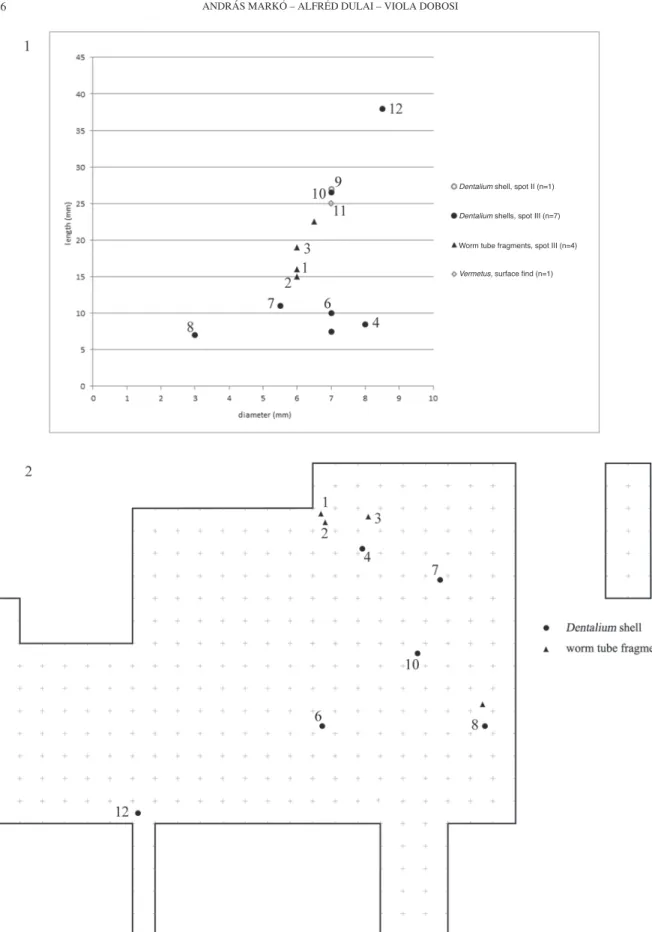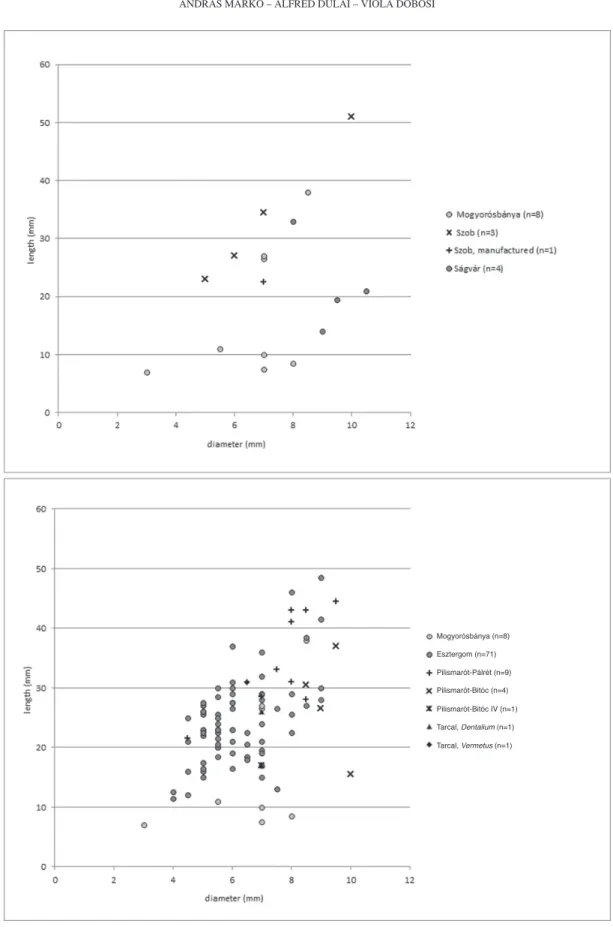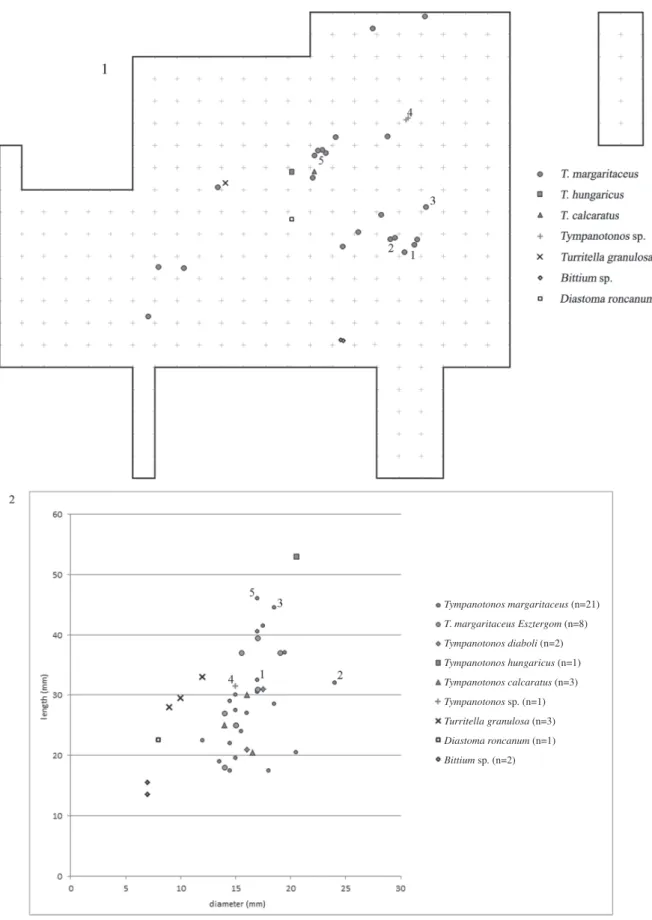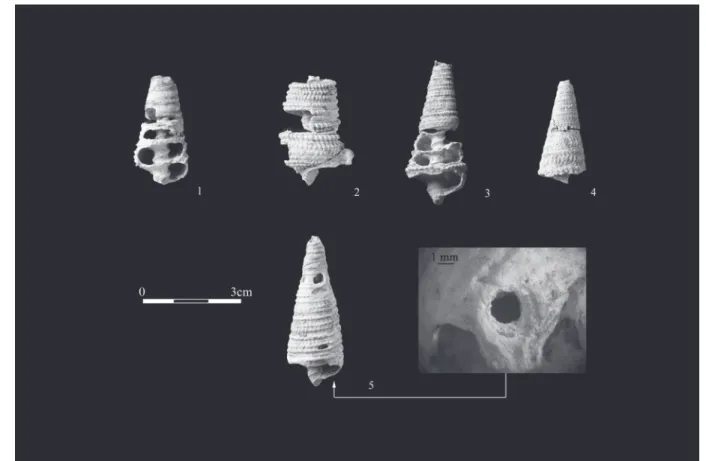Abstract:During the excavations of the Upper Palaeolithic site at Mogyorósbánya several non-utilitarian artefacts were found. Beside the earlier published piece of fossil resin (amber) and lumps of red ochre, more than one hundred Palaeogene and Neogene fossil molluscs, large foraminifers, corals and trace fossils from at least three different geological formations, as well as numerous fragments of phyllite were documented.
Pebbles of this soft shale were most probably collected from the alluvium of the Danube river. The majority of the pieces show clear traces of scraping and along the periphery of the largest artefact rhythmic incisions are visible. Even if this piece is not a ready-made object, it can be compared to the limestone and sandstone pebbles found on the Epigravettian site of Pilismarót-Pálrét.
Another interesting artefact of unknown function is a carefully shaped but strongly fragmented piece with sharp edge.
Fossils of the Eocene Epoch were easily accessible in the region of Mogyorósbánya, while the nearest fossiliferous out- crops of the Oligocene and Pannonian sediments are found 15–17 km in south-eastern direction from the site.
Few gastropod shells show unambiguous traces of human modification. Typically, among the 16 Melanopsis fossils found in a single square meter only three pieces were manufactured. On the other hand, the majority of the Dentalium and worm tube frag- ments were cut and their surfaces show intense rounding and shine.
The not modified Nummulites, corals and large internal casts of gastropods were most probably collected by Prehistoric humans because of their unusual form. This interesting group of the Mogyorósbánya artefacts and are compared to the fossils pub- lished from the Pilisszántó I rockshelter and to the not modified fossils from Moravia and Romania.
Keywords: fossil mollusc, coral, phyllite, perforation, spatial distribution
Non-utilitarian artefacts are relatively rare elements of the Palaeolithic assemblages in Hungary. Since the last review of these unusual pieces1 only short specialised papers have been published.2 In the present study the Palaeogene and Neogene fossils and phyllite artefacts excavated in the Mogyorósbánya site complex are analysed, with a focus on the taxonomic classification and source identification of the fossil remains, the human selection and manufacture of the pieces, as well as their spatial distribution in the excavated trenches.
On the Pebble Gravettian site of Mogyorósbánya-Újfalusi-dombok three discrete settlement units were excavated by V. Dobosi between 1984 and 2009.3 The in situ documented part of spot I and II reached 40 and 30 square meters, while spot III is the largest Upper Palaeolithic settlement unit in Hungary with more than 300 exca- vated square meters. The rich lithic industry, the remarkable large mammal fauna, a piece of fossil resin (amber)
– NON-UTILITARIAN ARTEFACTS IN THE UPPER PALAEOLITHIC – A CASE STUDY FROM MOGYORÓSBÁNYA (TRANSDANUBIA, HUNGARY)
ANDRÁS MARKÓ*–ALFRÉD DULAI**–VIOLA DOBOSI*
* Department of Archaeology, Hungarian National Museum 14–16, Múzeum krt, H-1088 Budapest, Hungary
markoa@hnm.hu, t.dobosi.viola@hnm.hu
** Department of Palaeontology and Geology, Hungarian Natural History Museum 2, Ludovika tér, H-1083 Budapest, Hungary
dulai.alfred@nhmus.hu
Acta Archaeologica Academiae Scientiarum Hungaricae 69 (2018) 227–252 DOI: 10.1556/072.2018.69.2.1
1 Dobosi 1985.
2 Magyar 1991a; Magyar 1991b; FölDvári 1992; Dulai
2007.
3 Dobosi 1992; Dobosi 2002; Dobosi 2011; Dobosi 2016.
and lumps of red ochre,4 documented in the h2 embryonic soil of the Hungarian loess stratigraphy5 and associated by two radiocarbon dates6 make possible the complex analysis of this site.
During the surface collections and the excavations 104 Palaeogene and Neogene molluscs, foraminifers and corals, as well as trace fossils were found (Table 1). The richest assemblage with 90 fossils and three fragments of burrow infill (cemented sand) were excavated in settlement spot III. After the successful refit experiments (Table 2) we estimate that 83 pieces were introduced to the excavated part of this settlement unit. The distribution map of the fossils shows three concentrations (Fig. 1.1) in the southern, middle and the south-eastern part of the excavated surface, respectively. The majority of the pieces were found, however, in a loose scatter.
4 FölDvári 1992; Mihály 2011.
5 Pécsi 1975.
6 The charcoal samples were collected from fireplaces dur- ing the excavations of settlement spots II (Deb-1169: 19.930±300 B.P.) and III (Deb-9673: 19.000±250 B.P.): Dobosi 1992; Dobosi– szántó 2003.
Table 1.
Mogyorósbánya: Palaeogene and Neogene fossils
spot I spot II spot III surface Total
Eocene fossils
Nummulites brongniarti (d’Archiac & Haime, 1853) 2 2
Isis sp. 1 1
Trochosmilia sp. 2 2
Circophyllia sp. 1 1
Turritella granulosa (Deshayes, 1832) 1 2 1 4
Diastoma roncanum (Brongniart, 1823) 1 1
Cerithium subcorvinum (Oppenheim, 1894) 2 2
Tympanotonos calcaratus (Brongniart, 1823) 1 2 3
Tympanotonos diaboli (Brongniart 1823) 1 1 2
Tympanotonos hungaricus (Zittel, 1862) 1 1
Tympanotonos sp. 2 2
Ampullina perusta (Defrance, 1823) 1 1
Ampullina sp. 1 1
Ancilla propinqua (Zittel, 1853) 1 1
Conus parisiensis (Deshayes, 1865) 1 1
Vermetus serpuloides (Deshayes, 1864) 1 1
Eocene fossils total 2 2 19 3 26
Oligocene fossils
Tympanotonos margaritaceus (Brocchi, 1814) 24 24
Aporrhais callosa (Telegdi-Roth 1914) 1 1
Dentalium kickxi (Nyst, 1843) 1 8 9
Oligocene fossils total 1 33 34
Pannonian fossils
Melanopsis fossilis (Gmelin, 1791) 3 3
Melanopsis impressa (Krauss, 1852) 1 20 21
Melanopsis sp. 2 2
Pannonian fossils total 1 25 26
Fossils from not identified epoch
Bittium sp. 2 2
Gastropoda indet. 1 3 4
Glycymeris sp. 1 1
Ostrea sp. 4 4
worm tube fragments 4 4
burrow infill 3 3
from not identified epoch total 1 16 1 18
Total 3 4 93 4 104
Artefacts of phyllite were reported earlier from the Epigravettian site Pilismarót-Bitóc in the Danube Bend (under the name of serpentinite).7 From the Mogyorósbánya locality 38 phyllite objects are known; 31 of them were excavated in settlement spot III. The spatial distribution of the 28 piece plotted artefacts is shown on Fig. 1.2.
PHYLLITE ARTEFACTS
The majority of the pieces are very small, platy fragments following the foliate structure of the rock. Dur- ing the analysis four larger artefacts were reconstructed. A typical flake was found in the eastern part of settlement spot III, five fragments of a not modified pebble and a sixth piece, lying at a distance of 1.5 meter was documented in the northernmost part of the excavated surface.
A manufactured and incised pebble (Fig. 2)8 was refitted from two fragments. The lateral parts of this piece were scraped (the pattern of ‘trace de brutage’ is clearly observed) and a short flake was removed from one of the edges. Along the opposite side of the pebble eight more or less parallel running, rhythmical and in two cases reas- serted incisions were performed. The faces of the pebble are covered by cortex and one of them was modified by deep, sub-parallel grooves at both ends of the piece. The marks on the thicker (‘distal’) part of the artefact suggest that it might have been fragmented during manufacture.
Sandstone and limestone pebbles with incised pattern, slightly smaller than the Mogyorósbánya piece were found on the Epigravettian site of Pilismarót-Pálrét9 in the Danube Bend. The carefully shaped limestone disc from the Early Gravettian locality of Bodrogkeresztúr-Henye10 (Tokaj Mountains, North-eastern Hungary) on the other hand was manufactured by powerful notches.
Artefacts of phyllite, marl and limestone with incisions around the perimeter and cutmarks on their surfaces were published from the Gravettian grave Brno II11 and from the settlement of Pavlov I in Moravia,12 as well as from the earliest Gravettian assemblage of Mitoc in the Prut valley,13 and the young Gravettian horizon of Poiana Cireşului in the Bistriţa valley (both in Romania).14 These pieces clearly differ from the Mogyorósbánya object by their small
7 Dobosi 2006, 41.
8 Its length is 56 mm, the width is 60.5 mm and the thick- ness is 22.5 mm.
9 Dobosi et al. 1983, 290, Fig. 5,6a–c.
10 vértes 1965; Dobosi 2000, 50–54.
11 Makowski 1892; oliva 2000.
12 svoboDa–Frouz 2011, Fig. 7b.
13 belDiMan–sztancs 2008, 69.
14 cârciuMaru et al. 2018, 236.
Table 2.
Mogyorósbánya III: conjoined fragments found in the cultural layer
nr. Inv. nr. species trench distance of the elements
1 Pb.92/038 Cerithium subcorvinum trench X, square 2 Fig. 13.2
Pb.92/046 trench X, square 3 125 cm
2 Pb.88/1021 Dentalium kickxi trench O excavation damage? Fig. 5.12
Pb.88/1046 trench O, square 30
3 Pb.92/18 Turritella granulosa trench X, –100 cm excavation damage?
Pb.92/57 trench X, square 4
4 Pb.2000/612 Tympanotonos margaritaceus trench α, square 17 Fig. 8.1
Pb.2000/659 trench α, square 17 40 cm
5 Pb.2000/666 Tympanotonos margaritaceus trench α, square 18 Fig. 8.2
Pb.2000/667 trench α, square 18 –
6 Pb.2000/696 Tympanotonos margaritaceus trench α, square 22 Fig. 8.3
Pb.2000/697 trench α, square 22 –
7 not inv. Tympanotonos margaritaceus
(2 pieces) trench γ, square 15 – Fig. 8.4
8 Pb.2002/21 burrow infill (2 pieces) trench β, square 5 – Fig. 13.1
Pb.2002/094 (possible refit) trench γ, square 5 270 cm
9 Pb.2000/721 Trochosmilia sp. trench α, square 29 – Fig. 13.4
Pb.2000/794 (possible refit) trench α, square 29
dimensions and the presence of perforation.15 The incised quartzite pebble with traces of red ochre from this later assemblage16 and the triangular artefact of sandstone with six incisions from Předmosti17 are seemingly similar to the Mogyorósbánya artefact; however, these items are interpreted as hammerstones or rubbing stones.
The morphology of the last phyllite artefact, a piece with sharp edge is similar to the polished axes (Fig. 3).
Together with seven fragments of the same item it was found in the south-eastern part of settlement spot III. The non-fragmented parts of the piece are covered by flat, manufactured surfaces, with the exception of the convex left
Fig. 1. Mogyorósbánya III. 1: Spatial distribution of the Palaeogene and Neogene fossils; 2: phyllite artefacts. Grid: 1 m
Fig. 2. Mogyorósbánya III. Manufactured and incised pebble (drawing: Katalin Nagy, photograph: Judit Kardos, HNM)
15 Moreover, in these assemblages incisions are also observed on a number of ʻrondelsʼ and other objects of haematite, bone, ivory and mammoth molar: e.g. Makowski 1892; cârciuMaru et al. 2018.
16 cârciuMaru et al. 2004, 123; cârciuMaru et al. 2018, 235.
17 absolon–klíMa 1977, 211, Taf. 199, 3471.
side, shaped also by scraping. On the large part of the other (flat or ʻventralʼ) face the natural cleavage surface of the pebble is visible. Unfortunately, the heavy fragmentation prevents the reconstruction of the original shape of this object, even if two amorphous pieces were conjoined to the largest fragment.18 Importantly, during the first trial excavations of spot III a little fragment of a similar artefact was found with manufactured surface, however, the exact place of the recovery was not documented.
The morphology of the piece with sharp edge is compared to the ochre artefacts of unknown function published, for instance, from Langmannersdorf.19 Possibly both ochre and phyllite were used during preparation of leather, however, the secondary carbonate layer, which covered the artefacts does not allow microscopic investiga- tions of the Mogyorósbánya pieces.
PALAEOGENE AND NEOGENE FOSSILS
The biostratigraphic evaluation of the fossil remains shows that one quarter of the pieces were collected from the local Eocene (55–33.4 million years old) sediments. The large foraminifer Nummulites or the Diastoma and Ampullina gastropods are common elements of these formations in the Carpathian Basin. Moreover, the occurrence of several taxa including corals has been reported from the surface outcrops in the vicinity of the site20 and from the Dorog Basin.21 The little cone shell Conus parisiensis, on the other hand, is not known from the Gerecse region until now, although the Neszmély outcrop yielded small sized molluscs.22 The nearest sources of the Tympanotonos
18 The dimensions of the reconstructed artefact are: length:
73.5 mm, width: 45.5 mm, thickness: 21.5 mm.
19 angeli 1953. nr. 50088, Taf. XI,1.
20 E.g. kolosváry 1949; szőts 1956, 99, 100.
21 bartha–kecskeMétiné körMenDi 1963.
22 strausz 1974.
Fig. 3. Mogyorósbánya III. Artefact with sharp edge of phyllite (drawing: Katalin Nagy)
hungaricus were reported from outcrops around Gánt lying at a distance of 43 km from Mogyorósbánya in south- western direction, where this gastropod was very abundant.23 Finally, the coral Isis may have been collected from the sediments lying around Páty, Nagykovácsi and Budapest24 (30 km from Mogyorósbánya in southern direction).
The spatial data of 16 piece-plotted Eocene fossils from spot III (Fig. 4.1) show a rather even distribution with two reconstructed refit groups (nr. 1 and 9).
One third of the fossil specimens are dated to the Upper Oligocene (Egerian stage: 25.8–20.3 Ma). Tym- panotonos margaritaceus is a common fossil of this period; the nearest occurrences of this species are known from several surface outcrops lying at a distance of at least 15 km in north-eastern (Kovačov, Malá nad Hronom), eastern (Kesztölc), southern and south-eastern (Tarján, Máriahalom) direction from the Mogyorósbánya site.25 At the same time, outcrops with Dentalium shells were mentioned from the region of Törökbálint, Pomáz, Diósjenő or Rétság,26 lying at a larger distance (31–46 km), and Aporrhais callosa was also described from the Upper Oligocene outcrops of Diósjenő.27
The spatial distribution of the 30 Oligocene specimens plotted in spot III (Fig. 4.2) show two clear con- centrations in the eastern part and the middle of the trench. With two exceptions the six refit groups (nr. 2–7) docu- ment the on-site fragmentation of the gastropod shells.
One quarter of the fossils from Mogyorósbánya belong to the Pannonian stage (11.6–7.4 million year). The two Melanopsis species are missing from the faunas of the northern and eastern part of the Gerecse Mountains28 and in the classical sediments of the Tata outcrops.29 One of the possible sources of these species is suspected in the outcrops around Tinnye (17 km from the site in south-eastern direction),30 close to the Máriahalom sandpit. More- over, similar fauna was also reported from the region around Kocs,31 lying at a distance of 30 km in western direction from Mogyorósbánya.
The distribution map of 24 Pannonian fossils plotted in spot III (Fig. 3.3) reflects a single artefact concen- tration in the southern part of the trench, clearly separated from the Oligocene scatters. Besides, only four pieces were documented in the middle and the northernmost part of the excavated territory.
Finally, in 18 cases the exact systematic, and therefore biostratigraphic determination of the fossils was not possible. The little fragments of thick bivalve shells, identified as oyster (Ostrea sp.) and the small gastropod Bittium are known both from the Late Oligocene32 and Eocene33 formations. Glycymeris is a common bivalve not only of this later period (the outdated term Pectunculus Sand refers the mass occurrence of glycymerids), but also in the Middle Miocene (Badenian stage: 16.3–12.8 million years ago) outcrops known in the south-western part of the Börzsöny Mountains.34
With the possible exceptions of this surface collected shell and the worm tubes Badenian fossils are absent from the Mogyorósbánya assemblages, which is surprising, as the Pebble Gravettian locality of Szob-Ipoly-part35 in the Danube Bend, yielding nearly 400 shells was specialised for collecting the fossil molluscs from this forma- tion. Moreover, Middle Miocene trinkets were also excavated on the Epigravettian sites of Pilismarót-Pálrét36 and probably Pilismarót-Bitóc, both lying on the opposite site of the Danube river. Finally, at Vác-Kis Hermányi út a single Badenian Cerithium (Thericium) michelottii shell, associated with an antler point and some flakes were found (unpublished data).37
In the contemporaneous Esztergom-Gyurgyalag assemblage Middle Miocene and Oligocene gastropods (eleven specimens of two species) were identified38 and the single gastropod shell found in the ʻLower Diluviumʼ
23 szőts 1953, 47. – The absence of this species in the Gerecse region was emphasised as having a clear palaeogeographical importance: szőts 1956, 152.
24 kolosváry 1949, 186; szőts 1956, 118.
25 seneš 1958; bálDi 1973; Janssen 1984.
26 bálDi 1973, 336.
27 bálDi 1973, 267 – Recently, both Aporrhais callosa and Dentalium kickxii (under the name of Antalis kickxii Nyst, 1843) were recorded from the Esztergom Basin, too: kovács–viczián 2016, 235, Plate I. Fig. 13.
28 Magyar et al. 2017.
29 korPás-hóDi 1983; Müller et al. 2007.
30 This locality is known after the more than one hundred years old and short note by lörenthey 1902.
31 strausz 1951, 286–288.
32 Máriahalom: Janssen 1984, 127.
33 Neszmély and Mogyorósbánya: strausz 1974, 42;
szőts 1956, 100.
34 csePreghy-Meznerics 1956; Dulai 1996.
35 gábori 1969; Markó 2007; Dulai 2007.
36 The assemblage is partly published by J. Szabó, see:
Dobosi et al. 1983.
37 The collected loess snails (including Vestia turgida) date the site to the same horizon as Esztergom and Pilismarót – kind com- munication by E. Krolopp (06. 10. 1999.).
38 Tympanotonos margaritaceus and Pirenella plicata:
Magyar 1991a.
(late Gravettian) layer of the Pilisszántó I rock shelter in the Pilis Mountains, Transdanubia39 was probably collected from Oligocene sediments, too.
The use of Pannonian melanopsids is known from the Epigravettian site of Jászfelsőszentgyörgy-Szúnyogos (in the northern periphery of the Great Hungarian Plain),40 from Verseg-Kertek alja (Cserhát region, Northern Hun- gary) and from the Čertova pec cave (near Radošina, Western Slovakia)41 tentatively placed to the earlier Upper Palaeolithic period and the Gravettian. At the same time, the biostratigraphic age of the fossil shells from the Bivak cave (Pilis Mountains),42 Ságvár (south of Lake Balaton)43 Csővár (Cserhát Mountains)44 and Tarcal (Tokaj Moun- tains in North-Eastern Hungary)45 is not known precisely.
THE HUMAN SELECTION
Obviously, Palaeolithic humans followed different considerations than the taxonomic, biostratigraphic or palaeoecological approach used by present-day palaeontologist. As Eocene and Oligocene species of the Tympa- notonos genus (T. calcaratus, T. hungaricus and T. margaritaceus) were found in the same find concentration in settlement spot III, a possible classification of the excavated fossils is based on apparent morphological features of the specimens.
39 korMos–laMbrecht 1915, 339.
40 Dobosi 1993, 47.
41 Prošek1950, 179, Obr. 119; bárta 1965, 122, Tab.
XXV; bárta 1965 1972, 79, Obr 3.
42 Jánossy et al. 1957.
43 With the exception of a possible Pannonian bivalve, see infra.
44 Patay 1932.
45 Dobosi 1974.
Fig. 4. Mogyorósbánya III. Spatial distribution of the Eocene (1), Oligocene (2) and (3) Pannonian fossils. Grid: 1 m
Earlier, Y. Taborin46 distinguished seven groups among the perforated and suspended gastropods known from the Palaeolithic sites in France. However, the species Ancilla glandiformis was listed both among the ovoiide and fusiforme fossils,47 while Turritella and Tympanotonos shells known from the Mogyorósbánya collection were identified as en forme de cône allongée.
Based on the fossil mollusc assemblages from the Pavlovian sites in Moravia, Š. Hladilová described four morphological groups: smooth ovoid shells (like Conus, Melanopsis and Ancilla), tower-like shaped shells (Turri- tella), tubular remains (Dentalium and Serpula) and radial sculptures (basically bivalves),48 noting that the surface of ovoid shells are generally smooth, while tower-shaped fossils are often ʻsculpturedʼ.49
The most obvious groups of the intuitive classification of the Mogyorósbánya pieces (Table 3) are the tu- bular fossils (scaphopods and worm tubes), the gastropods with rich ornamentation as nodes and ribs on the shells (typically, Tympanotonos) and the simple gastropod shells with smooth surface (e.g. the melanopsids). Bivalves (or pieces with radial sculptures) are represented by a single surface-collected Glycymeris and some strongly frag- mented Ostrea shells, found during the cleaning of the easternmost and the middle part of spot III. Bivalves gener- ally played a subordinate role in the Palaeolithic assemblages in Hungary, even if the oldest fossils known from archaeological context in Hungary are the Glycymeris obovata shell, mentioned from the Late Middle or Early Upper Palaeolithic leaf-point assemblage of the Remete Upper cave50 and a Cardium from Verseg.51 From Ságvár- Lyukas-domb, sorted into the same Pebble Gravettian industry as the Mogyorósbánya assemblage the presence of an Arca diluvii was reported.52 Another bivalve shell53 (possibly Prosodacnomya sp. from the Pannonian sediments of Tab and Kötcse lying close to Ságvár54) was catalogued in the Palaeolithic collection of the National Museum 25 years after the end of the last excavations of this site. Regrettably, the find circumstances of this fossil, not men- tioned in the field notes and the preliminary reports by M. Gábori are not known.
46 taborin 1993, 265.
47 taborin 1993, 266, 268 – Melanopsids were sorted into the latter group.
48 hlaDilová 2005, 382.
49 hlaDilová 2005, 383.
50 gábori-csánk 1993, 267–269. – Today this shell is missing from the collection of the Budapest History Museum.
51 Magyar 1990a.
52 According to M. Gábori and V. Gábori this shell was excavated at an unknown place of the site (gábori–gábori 1957, 13), while the inventory book of the National Museum indicates that it was found by S. Gallus after 1935. In fact, the first photo of the artefact was published in a report on the 1930 excavation (laczkó et al. 1930, 220, 304, Taf. 140).
53 Dobosi 1985, 26, Fig. 3,6.
54 Müller–Magyar 1992.
Table 3.
Morphological groups of the fossil artefacts from the Pebble Gravettian Epigravettian and from not dated archaeological sites in Hungary (without Pleistocene species and fragmented pieces)
bivalve ornamented gastropod simple gastropod tubular fossil ’other fossil’ total
Mogyorósbánya I 1 1 1 3
Mogyorósbánya II 2 1 3
Mogyorósbánya III 4 34 31 12 11 90
surface 1 2 1 4
total 5 39 30 14 12 100
Szob 31 321 40 5 397
Ságvár 1 4 5
Esztergom 17 5 73 91
Pilismarót-Pálrét 2 9 11
Pilismarót-Bitóc, Lower layer 2 3 1 6
Pilismarót-Bitóc, Upper layer 4 4
Vác-Kishermányi út 1 1
Bivak cave 1 1
Jászfelsőszentgyörgy 1 1
Tarcal 2 2
Verseg-Kertekalja 1 3 1 1 6
Csővár-Csővár cave 3 3
On the third Pebble Gravettian site, Szob-Ipoly part 8% of the important mollusc assemblage was bivalves.55 Finally, in the unpublished lower layer of the Epigravettian site of Pilismarót-Bitóc two bittersweet (Glycymeris) shells, and in the contemporaneous layer of the Bivak cave a fragment of an Arca or Glycymeris was found.56
Tubular fossils
In the Mogyorósbánya collection 14 Dentalium and Vermetus shells, as well as worm tube fragments are identified, each showing traces of human manipulation. The Dentalium and Vermetus shells were sliced and the three worm tube fragments with a uniform diameter and similar length data suggest for the on-site cutting of a single fossil, even if the fragments are not conjoined. On the other hand, the eroded longitudinal ribs and the notches on the rounded extremities indicate the traces of intense use of the pieces (Fig. 5). Accordingly, the majority of the Dentalium fragments are 7–11 mm long (Fig. 6.1). Two tusk shells and the single Vermetus remain form another closed group (with a length of 25–27.5 mm), however, one must take into consideration that the Dentalium speci- mens were excavated both in settlement spot II and III (Fig. 5.9, 10) and the Vermetus (Fig. 5.11) was collected on the surface as a stray find.
The spatial data of the pieces found in spot III show a relatively even distribution in the eastern part of the excavated trench (Fig. 6.2), with a single concentration of three worm tube fragments. At the same time, the longest Dentalium (refitted from two fragments: Fig. 5.12) was collected in the south-eastern part of spot III.
55 Dulai 2007 – In the assemblage collected at the nearby geological outcrop on the traditional way (without wet-sieving) and stored in the Natural History Museum bivalves are important ele- ments, represented by 23%: Dulai 1996, 44.
56 Jánossy et al. 1957, 31, Taf. I, 2. – A recently obtained radiocarbon date (Gd-15614: 15.970±207 B.P., see Pazonyi 2006, 81) places the upper yellow layer of this cave to the Epigravettian period.
Fig. 5. Mogyorósbánya. Tubular fossils from the excavations (worm tube: 1–3; Dentalium: 4–9, 12; Vermetus: 11) from settlement spot II (9) and III (1–8, 12) and from the surface (11)
Fig. 6. Mogyorósbánya. Metrical data (a) and spatial distribution of the tubular fossils in settlement spot III (b). For the legend see Fig. 5
Dentalium shell, spot II (n=1)
Dentalium shells, spot III (n=7)
Worm tube fragments, spot III (n=4)
Vermetus, surface find (n=1)
The Dentalium remains from Szob are longer than the Mogyorósbánya specimens (Fig. 7.1), partly be- cause the Badenian tusk shells are larger than the Oligocene pieces,57 partly as only one manufactured Dentalium shell is found today in the collections from this site.58
From Ságvár a single Dentalium bead, found before the Second World War was published.59 The report on the 1957 excavations mentioned four pieces with a length of 1 to 3 cm from the upper culture layer.60 The shells published later on a photograph61 are longer than these data, which may raise further questions about the find cir- cumstances of the pieces and points to the problems at the analysis of the assemblage of this important site.62
In the Epigravettian assemblage of Esztergom-Gyurgyalag and Pilismarót-Pálrét,63 as well as the strati- graphically younger upper layer of Pilismarót-Bitóc (unpublished data) tusk shells were the most popular fossil trinkets and on the Tarcal site only tubular fossils: a Dentalium and a Vermetus remains were excavated.64 From metrical point of view, these artefacts are clearly longer than the manufactured pieces from Mogyorósbánya (Fig. 7.2), which reflect the preference for short beads on this later site.
On the Palaeolithic localities of Lower Austria, scaphopods constitute the most numerous group of fossils at Grubgraben65 and exclusively Dentalium shells were found at Langmannersdorf,66 both dated roughly to the same period as the Mogyorósbánya locality. Several hundreds of Dentalium and some Serpula shells were found in the Late Gravettian site of Moravány-Podkovica (Váh valley, Western Slovakia)67 and Dentalium specimens were also reported from the surface collected assemblage of the same period from the nearby Hubina I locality.68
As a total, the Mogyorósbánya and Szob assemblages, characterised by the moderate number of tubular fossils clearly differ from the Epigravettian pattern, and that one, known from Western Slovakia and Lower Austria, all dominated by scaphopods. On the other hand, In Romania a single Dentalium bead was excavated until now, in the Gravettian layer I at Poiana Cireşului;69 the metrical data of this piece are even smaller than the Mogyorósbánya species.
Ornamented gastropods
The species of Tympanotonos, Turritella and the little shells of Diastoma and Bittium are identified as ornamented gastropods in this paper. The spatial distribution of 31 piece-plotted shells (Fig. 8.1) shows two con- centrations. In the middle of spot III different Tympanotonos species from different geological formations were documented, while in the south-eastern part several of on-site fragmented the pieces (Table 2, Fig. 9.1–3) were found. The interpretation of refit groups 4-6 is rather problematic,70 especially, as in the Máriahalom sandpit gast- ropod fragments, very similar to the Mogyorósbánya pieces were documented,71 suggesting that the given pattern of the fragmentation does not necessarily indicate human impact. The minimal dislocation of the elements of each refit group shows that probably sediment pressure or trampling caused the fragmentation.
57 bálDi 1973, 336.
58 According to the field notes of A. J. Horváth in 1937 ten Dentalium beads were excavated in the lower layer of this site (Dobosi–vári 1997, 70). These artefacts are, however, missing from the collections today.
59 gábori–gábori 1957, 13.
60 gábori–gábori 1958, 22; gábori 1959, 5, 12. – In fact, in the short type-written description from this season (stored under the number 203.S.III. in the Archives of the Hungarian National Museum) only three Dentalium beads were mentioned.
61 gábori 1964, 40, T. VIII.
62 These artefacts and the Prosodacnomya shell were got into the Palaeolithic Collection of the National Museum after closing of the prehistoric exhibition of the Veszprém Museum in 1974.
63 Magyar 1991a; szabó 1983.
64 Dobosi 1974, 12.
65 neugebauer-Maresch et al. 2016, 233.
66 angeli 1953.
67 zotz–vlk 1939, 85–86, Taf. XIX; bárta 1965, 103, 124; bárta 1970, 209; hroMaDa 1998, 155.
68 Prošek 1950, 183; bárta 1950; bárta 1965, 103, 124;
hroMaDa–ŽeMla 2000, 88–89.
69 cârciuMaru et al. 2018, 231–232, Fig. 2/7.
70 The meaning of the term ʻtaphonomyʼ is not unambi- guous in this case. From paleontological point of view, human modi- fication of fossil molluscs is a clear taphonomic event, observed on the reworked shell, i.e. the palaeontology’s loss is archaeology’s gain.
The fragmentation of the abandoned pieces in the artefact-bearing layer, e.g. due to the sediment pressure, on the other hand is tapho- nomic action for both fields and the palaeontology’s and archaeolo- gy’s loss is sedimentology’s gain.
71 Janssen 1984, Fig. 3.
Fig. 7. Mogyorósbánya. Metrical data of Dentalium specimens compared to pieces from the Pebble Gravettian (1) and Epigravettian (2) assemblages
Mogyorósbánya (n=8) Esztergom (n=71) Pilismarót-Pálrét (n=9) Pilismarót-Bitóc (n=4) Pilismarót-Bitóc IV (n=1) Tarcal, Dentalium (n=1) Tarcal, Vermetus (n=1)
Fig. 8. Mogyorósbánya. Spatial distribution (1) and metrical data (2) of the ornamented gastropods. For the legend see Fig. 9 Tympanotonos margaritaceus (n=21) T. margaritaceus Esztergom (n=8) Tympanotonos diaboli (n=2) Tympanotonos hungaricus (n=1) Tympanotonos calcaratus (n=3) Tympanotonos sp. (n=1) Turritella granulosa (n=3) Diastoma roncanum (n=1) Bittium sp. (n=2)
Only the largest Tympanotonos margaritaceus shell, found in the first concentration shows traces of human manipulation (drilling with rotational movement), carried out on the last whorl of the shell (Fig. 9.5).72 The apical part of the same specimen is intensively worn in as much, that the natural ornamentation and the thick wall of the shell was completely eroded. Possibly these localised traces document the use of this unique piece. Unfortunately, the heavily fragmented and sometimes eroded shells do not let to draw any further conclusions.
On the Epigravettian site of Esztergom-Gyurgyalag, dominated by tubular fossils some ornamented gast- ropod shells were also excavated. The metrical data measured on the T. margaritaceus and T. hungaricus specimens from Mogyorósbánya and Esztergom-Gyurgyalag (Fig. 8.2) fit to the range of the fossils of the Máriahalom and Gánt outcrops; the length of the shells did not reach the maximal dimensions of these species73 as it was suggested in the case of the Glycymeris found in the Remete Upper cave.74
Turritella is represented by four fragments of three specimens in the Mogyorósbánya assemblages; the piece excavated in spot III (refit group 3) and the small Diastoma and Bittium remains were found relatively far from the large ornamented shells.
Turritella species are the dominant elements of the Szob collection, representing 83.65% of gastropods and 78.39% of the fossil remains in general.75 In the lower layer of Pilismarót-Bitóc three turritellids were found, and a number of specimens were collected during the surface prospections in the vicinity of this site. Bearing in
Fig. 9. Mogyorósbánya III. Ornamented Tympanotonos shells. Refit groups 4–7 (1–4) and manufactured piece (5)
72 Borings of the predatory naticid and muricid molluscs, showing circular pattern were documented on 0.9% and 1% of the gast- ropod shells collected in the Máriahalom sandpit: ollé 1996, 15–16.
– The conical cross-section of the hole observed on the Mogyorósbánya specimen is similar to the borings by the former group of predatory gastropods (D’errico et al. 1996, 246–248, Fig. 4A, 5A). However, the observed asymmetric cross-section of the oval perforation, the presence
of striations along its periphery and the absence evidences of chemical alteration caused by the acids secrated by the naticids, suggest for a human manipulation (D’errico et al. 1996, 250, Fig 7).
73 The maximal length of the shells from these outcrops is 6 cm: Janssen 1984, 126; szőts 1953, 47.
74 gábori-csánk 1993, 267–269.
75 Dulai 2007.
mind the Turritella shell found in the Gravettian layer of the Pilisszántó I rock shelter76 the importance of this or- namented gastropod during the Late Upper Palaeolithic is evident.
Simple gastropods
The 26 melanopsids together with the single shells of Conus, Ancilla and Aporrhais77 are referred as ʻsimple gastropodsʼ. Their spatial distribution with a very pronounced concentration of 17 M. impressa shells, seemingly elements of a single ʻropeʼ or ʻnecklaceʼ is presented on Fig. 10. Moreover, in the vicinity of this feature three large melanopsids (M. fossilis) and a worn snail shell (Gastropoda indet.) were documented in a relatively closed scatter.
At Szob numerous fossil molluscs, collected by in the immediate vicinity of the site and several heaps of shells were excavated in 1939, 1940 and 1964 by A. Horváth, M. Mottl and M. Gábori.78 No spatial information is available about the melanopsids, including numerous fragmented pieces found in a cryoturbated layer in the Čertova pec cave79 and about the elements of the reconstructed necklace of Dentalium beads from Moravány-Podkovica.80 On the other hand, the 13 fossil shells (cca. 14% of the trinkets) excavated in a single square meter at Esztergom- Gyurgyalag81 and the Dentalium beads found in the first Palaeolithic dwelling structure at Ságvár implied a kind of rope, similar to the Mogyorósbánya observations. Finally, a complete necklace with 10 perforated Homalopoma sanguineum and 38 Lithoglyphus naticoides shells were reported from the 26 ka old Gravettian III layer at Poiana Cireşului.82
In the case of the supposed necklace from Mogyorósbánya only three specimens show traces of human modification. One of them (Fig. 11.1) was clearly perforated,83 on another shell the trace of not finished sawing is documented (Fig. 11.3).84 A large hole (with the dimensions of 7.5×5 mm) possibly of natural origin85 on the apical third of a shell could have been utilised by humans (Fig. 11.2). One of the melanopsids found relatively far from the concentration, among ornamented Tympanotonos shells was broken during the perforation or preparation by scraping, performed close to the aperture (Fig. 11.4).86 Finally, on some pieces (including two elements of the
‘necklace’) the rather irregular holes may also be regarded as human manipulations. However, their location (close to the apex of the shell) and their small dimensions (0.7x1.5 mm) question the validity of this interpretation.
The single Aporrhais and Ancilla remains (Fig. 11.5–6) excavated at a distance of 65 cm from each other, in the Tympanotonos margaritaceus concentration were manufactured on the back of the shell, opposite to the aper- ture.87 In this later case, the upper margin of the hole is most probably a regenerated natural injury while the lower one is of human origin. Importantly, the metrical data of these two specimens are very close to the Melanopsis shells showing unfinished sawing and scraping (Fig. 11.3,4; Fig. 12).
Similar pattern of manufacture was identified on a Tympanotonos shell from Esztergom-Gyurgyalag and on the large Conus shell in the unpublished material from the lower layer of Pilismarót-Bitóc. Moreover, in the available literature several pieces with traces of sawing were reported, i.e. from the Late Gravettian assemblage from Mainz-Linsenberg,88 from the Čertova pec cave89 and on the Conus ventricosus and Cypraea sanguinolenta specimens from Moravány-Žakovska (Váh valley, Slovakia).90
76 korMos–laMbrecht 1915, 339, Fig. 15.
77 In fact, the labelling of this later species shows the weak- ness of our classification. Although there are no large ribs on the shell, the fingers make Aporrhais clearly different from the other pieces of ʻsimple gastropodsʼ.
78 Dobosi–vári 1997, 74; Mottl 1942; gábori 1969, 8–9, Taf. II, 2; Markó 2007.
79 At least 20 Lithoglyphus and 23 Melanopsis shells are known from this site: Prošek 1950, 179, Obr. 119; bárta 1965, 122, Tab XXV; bárta 1972, 79, Obr 3. – This site is interpreted as a work- shop from trinket production, see: Prošek 1950, 179; bárta 1965, 122; bárta 1970, 208.
80 bárta 1965, 124, Tab. XXXV, 1.
81 Dobosi–kövecses-varga 1991, 239.
82 nitu–carciuMaru 2018; c.f. belDiMan–sztancs 2008, 72; cârciuMaru–ȚuȚuianu-cârciuMaru 2012.
83 By sawing, see: D’errico et al. 1993, 250, Fig. 6D.
84 In both cases the perforation is located between the aper- ture and the back of the shell, i.e. at the place E1–E2 following the system by taborin (1993, 170, Fig, 51).
85 Probably trace of an attack by a decapod crustacean, see:
görög–soMoDy 1988, ollé 1996, 18–19.
86 At location E1b by taborin 1993.
87 At location E3 by taborin 1993.
88 hahn 1969, 62, Bild 12,2.
89 bárta 1965, 122.
90 bárta 1965, 125, XXXVI, 10–11.
Fig. 10. Mogyorósbánya III. Spatial distribution of the simple gastropods (grid: 1 meter). For the legend see Fig. 11
ʻOther fossilsʼ
Twelve artefacts from Mogyorósbánya differ from the pieces discussed above. The burrow infill (Fig. 13.1) of unknown geological age and Eocene corals (Fig. 13.3–5), internal casts of gastropods (Fig. 13.2) and Nummulites (Fig. 13.6–7) were most probably collected because of their unusual form.91 With the exception of a single coral fragment these pieces were excavated in spot III, basically in the eastern and north-eastern part of the trench (Fig. 14). The role of these fossils are compared to the not modified Mesozoic brachiopods92 from Dolní Vĕstonice II, the Badenian coral from Milovice I,93 and the four Congeria shells from Poiana Cireşului.94 The not modified mammoth molar95 and probably the Nummulites96 found in the Epigravettian artefact-bearing layer of the Pilis-
Fig. 11. Mogyorósbánya. Simple gastropods (1–4: Melanopsis impressa; 5: Ancilla propinqua; 6: Aporrhais callosa) with traces of manufacture and use
91 The two refitted fragments of the internal cast Cerithium subcorvinum is the largest fossil of the Mogyorósbánya collection with the lenght of 75.5 mm, the diameter of 29.5 mm and the weight of 69.95 g. From the Middle Eocene outcrops of Gánt and Dudar, the presence of considerably larger shells were reported (szőts 1953, 50, 51; strausz 1966, 30), showing the humans probably did not seek after the largest available specimen. – Following a. leroi-gourhan
(1965, 212–214) one can interpret the presence of these unusual pieces in the artefact-bearing layers as the first traces of scientific interest.
92 hlaDilová 2016.
93 hlaDilová 1994, 24, Fig. 4.
94 belDiMan–sztancs 2008, 71; cârciuMaru et al. 2004, 125–126; cârciuMaru et al. 2018, 248. – These shells, covered by traces of red ochre are interpreted as female representations.
95 korMos–laMbrecht 1915, 422.
96 korMos–laMbrecht 1915, 339. – According to the ex- cavator, however, these pieces could also have been transported to the cave in the craw of the birds.
szántó I rockshelter and the fossil shells found at Verseg were also interpreted as pieces which were collected as exotic items.97 Some manufactured Dentalium shells found in Esztergom and a single piece from Szob each filled with the original marine sediment may also belong to this category. Finally, the unmodified pebbles with a shape and dimensions of a pigeon’s egg and a piece of clay mentioned from the first dwelling structure of the Ságvár site98 or the 119 globular concretions documented at Langmannersdorf99 were most probably collected by Prehistoric humans as unusual forms.
NOTES ON THE SOURCE AREAS OF THE FOSSILS
The analysis of the trinkets excavated at Esztergom raised certain questions about the source determination of some Badenian fossils, because three gastropod species are not known from the nearest outcrops at Szob and Letkés.100 As the lithic industry from this site was dominantly made of the extralocal Prut flint,101 the fossil trinkets were not necessarily collected from a source region lying close to the archaeological locality. In fact, Badenian deposits with well-preserved Dentalium shells were reported from the Vienna Basin (e.g. from the type locality at Baden) and Styria, as well as the environs of Sopron, Budapest, Szilvásvárad, the Mecsek Mountains and from the southern part of the Transylvania,102 too. Theoretically, each region can be considered as a potential source of the excavated fossils. A similar problem is emerged at the interpretation of the Oligocene molluscs found in the Mogyorós bánya assemblage: the sources of the Tympanotonos, Dentalium and Aporrhais specimens may suggest
97 Magyar 1991b.
98 gábori–gábori 1958, 22; gábori 1959, 5, 12. – These artefacts, together with the crescent shaped pendant (or fragment of a ring) and a bone tool found in the same feature are not found among the catalogued pieces from the last excavations.
99 angeli 1953, Abb. 18.
100 Conus antediluvianus, Surcula serrata and Genota ra- mosa valeriae: Magyar 1991a, 265. – The presence of this later spe- cies, however, was reported from the archaeological assemblage of Szob-Ipoly-part (csePreghy-Meznerics 1956).
101 Dobosi–kövecses-varga 1991; Dobosi 2010.
102 csePreghy-Meznerics 1951, 80.
Fig. 12. Mogyorósbánya III. Metrical data of simple gastropods. For the legend see Fig. 11
Melanopsis impressa (n=21) Melanopsis fossilis (n=3) Melanopsis sp. (n=1) Ancilla propinqua (n=1) Aporrhais callosa (n=1) Gastropoda indet. (n=1) Conus parisiensis (n=1)
for different source regions and different palaeo-communities, even if in the vicinity of Diósjenő the occurrence of each species is known.103
Generally speaking, it is possible, that although a given species, present in the archaeological layers were not recorded in paleontological papers, they may occur as a rare member of the fossil assemblages of a region.104 For instance, in the Máriahalom sandpit the different fossil-rich lenses and pockets sampled during the decades yielded faunas of slightly different composition;105 this way 17–21 thousand years ago different geological layers with slightly different fossils could have been accessible for Prehistoric humans.106
On the other hand, the type locality of the Late Oligocene Egerian stage yielding Tympanatonos, Dentalium and Aporrhais shells is found in the former Wind brickyard in Eger107 lying at a distance of 135 km from the Mo- gyorósbánya site. Furthermore, the fauna collected from the Pannonian outcrop in the neighbouring Ostoros is al-
103 bálDi 1973, 260–261, 267, 336.
104 About the possible role of the drifting algae, see: szabó
1983, 206.
105 Janssen 1984.
106 For instance this way, the outcrop at Esztergom- Szentgyörgymező yielding Dentalium and Aporrhais shells (kovács– viczián 2016), lying directly on the bank and in the bed of the Danube river was most probably not accessible during the Late Pleistocene.
107 telegDi-roth 1914; bálDi 1973.
Fig. 13. Mogyorósbánya. ʻOther fossils’ from settlement spot II and III
(1: burrow infill, 2: Cerithium subcorvinum, 3: Circophyllia sp., 4-5: Trochosmilia sp., 6–7: Nummulites brongniarti)
most identical with the Tinnye material108 and from the nearby Noszvaj and Kács fossiliferous Eocene sediments (with Isis, Trochosmilia, Circophylia corals)109 were reported. As a total, the occurrence of each fossil species evi- denced from the Mogyorósbánya site is known from a minor region in the south-western part of the Bükk Moun- tains. Importantly, these outcrops are found along a possible route leading from the northern part of Transdanubia to the obsidian sources in North-Eastern Hungary and South-Eastern Slovakia, which can be an important as 3.13%
of the Mogyorósbánya ‘lithic assemblageś’ are made of this volcanic glass.110
As a conclusion, we suggest that the data about the present day occurrences of a given fossil in the geo- logical formations can be used only as an approximation to estimate the nearest sources of the shells found during the archaeological excavations. However, it is not possible to decide without further considerations if the studied pieces were collected from local sources or they were transported to the site from a larger distance. In the Mogyorósbánya assemblages the single Aporrhais and the few Dentalium shells were both manufactured and used, while only one Tympanotonos was drilled. These archaeological observations let us to suppose that former species and the Tympa- notonos shells were collected from two distinct source areas, and that the latter formation was lying relatively closer (around 15 km, e.g. at Máriahalom) to the archaeological site than the former one (more than 30 km, at Diósjenő).
On the other hand, the coral and Nummulites remains, as well as the internal cast of gastropods are consid- ered as collected from locally available Eocene sediments.
NON-INTENTIONAL, OCCASIONAL AND SYSTEMATICAL COLLECTION
In our view, the majority of these later species,111 represented by single, non-manufactured fossils were collected occasionally, on a not systematic way, probably during the lithic raw material procurement. For instance, in the Hejszoba vineyards, lying 2.5 km from the site, a surface outcrop of the Cretaceous grey chert pebbles, mac- roscopically similar to the main raw material of the excavated artefacts was mapped;112 from the same hill the oc- currence of a number of Eocene fossils was also reported.113 Similarly, phyllite pebbles could have been found during the pebble raw material collection in the nearby terraces of the Danube river and the piece of amber, exca- vated in the southern section of spot III (Fig. 14) may belong the same category: in Silesia this fossil resin is found in the Pleistocene age end moraines,114 together with the excellent quality flint, well represented in the Mogyorós- bánya assemblage.
The occurrence of very small fragments of the thick walled Ostrea shells in the artefact bearing layer is also linked to the raw material collection, however, in the absence of larger pieces it is interpreted as not intentional by products of the exploitation of Tertiary pebble-bearing sediments.
Finally, the selected ornamented and simple gastropods, partly excavated in little find concentrations were most probably introduced to the site after a systematic collection from single outcrops.115 The manufactured tubular fossils, the Ancilla and Aporrhais shells, and probably the two Bittium specimens, documented in spatially well limited parts of the excavated surface belong to the same group.
…THE GREAT OCEAN OF TRUTH LAY ALL UNDISCOVERED BEFORE US
The grave finds like Brno II may offer an easy starting point for the explanation of the pieces discussed in this paper. Beyond some basic conclusions, however, the interpretation can be rather doubtful, especially if one uses the phrases like magician or shaman.116 However, in 1966 the detailed documentation of a burial in Colombia
108 Jankovich 1969.
109 kolosváry 1956.
110 Markó 2017.
111 Possibly with the exception of the Nummulites, see note 95.
112 FülöP 1958; giDai 1973.
113 Tympanotonos calcaratus, T . diaboli, Diastoma ronca- num, Ampullina perusta, Cerithium subcorvinum, and the genera Cir- cophyllia, Trochosmilia, Ostrea, Nummulites and Bittium: szőts
1956, 99, 100.
114 nieDźwieDzki 2015.
115 The sporadic occurrence of the Eocene Tympanotonos calcaratus and T. hungaricus remains compared to the numerous Oli- gocene T. margaritaceus shells, found in the same concentrations is interpreted by the differences in the occasional and systematic collec- tion methods.
116 zotz 1951, 223–225; oliva 2000.
